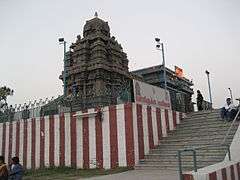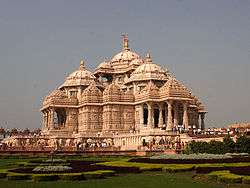Uttara Swami Malai Temple
| Uttara Swami Malai Temple | |
|---|---|
|
Sree Swaminatha Swami Temple at the Malai Mandir Complex in Delhi | |
 Uttara Swami Malai Temple Location in Delhi | |
| Name | |
| Proper name | Uttara Swami Malai Temple |
| Geography | |
| Coordinates | 28°34′3″N 77°9′56″E / 28.56750°N 77.16556°ECoordinates: 28°34′3″N 77°9′56″E / 28.56750°N 77.16556°E |
| Country | India |
| Location | R. K. Puram, New Delhi [1] |
| Culture | |
| Primary deity | Sree Swaminatha Swami |
| Architecture | |
| Architectural styles | Tamil Architecture |
| History and governance | |
| Date built | Jun 7, 1973 |
| Creator | Sri Swaminatha Swami Seva Samaj |
Uttara Swami Malai Temple (Tamil: உத்தர சுவாமி மலை கோவில்), popularly known as Malai Mandir (literally, Hill Temple), is a Hindu temple complex in New Delhi located on the affluent Palam Marg primarily dedicated to Lord Swaminatha (more commonly known as Lord Murugan), most revered by the religious Hindus of Tamil, Telugu, Malayalam and Kannada community in the city.[2][3]
Architecture
The main temple within the complex, formally called Sree Swaminatha Swami Temple, houses the sanctum sanctorum of Lord Swaminatha. It is situated atop a small hillock in Sector-7 R.K. Puram and overlooking Vasant Vihar in South West Delhi. This is in keeping with the tradition of locating Murugan temples on hills. The sign outside the main temple is written in Tamil, proclaiming Lord Swaminatha's motto, "Yaamirukka Bayamain" meaning "Why fear when I am there?". The temple is built entirely of granite, and is reminiscent of the Chola style Tamil Architecture.
Besides the main Swaminatha Swami Temple, the complex contains temples dedicated to Sree Karpaga Vinayagar (elder brother of Lord Swaminatha), Sree Sundareswarar (father of Lord Swaminatha) and Devi Meenakshi (mother of Lord Swaminatha). These subsidiary temples draw inspiration from the Pandya style of dravidian Architecture, as can be seen at the historic Meenakshi Amman Temple in Madurai, Tamil Nadu.
In the Hindu religion, the peacock is considered Lord Swaminatha's mount or vahana. Accordingly, the temple has adopted a peacock as its pet. This peacock can be seen and heard among the trees and foliage within the temple compound.People from various backgrounds visit the temple .
History
- Sep 8, 1965 The foundation stone for the temple is laid by M. Bhakthavatsalam, Chief Minister of Tamil Nadu, at a function held under the presidency of Sri Lal Bahadur Shastri, then Prime Minister of India.
- Jun 7, 1973 The main temple for Lord Swaminatha - Sree Swaminatha Swami Temple - is consecrated and a Mahakumbhabhishekham performed.
- Jun 13, 1990 The temples for Sree Karpaga Vinayakar, Sree Sundareswarar and Devi Meenakshi are consecrated and Mahakumbhabhishekhams performed. A Jeeranoddharana Kumbhabhishekham for the Lord Swaminatha temple is also performed on the same day.
- Jul 7, 1995 The Navagraha temple (nine planets), along with a small temple for Idumban Swami, is consecrated and Kumbhabhishekham performed.
- Nov 9, 1997 The Adi Sankara Hall is inaugurated.
- Jun 27, 2001 The third Punaruddharana, Ashtabandhana and Swarna-Rajatha Bandhana Mahakumbhabhishekham of the temples are performed by H.H. Kanchi Kamakoti Peethadhipati Sri Jayendra Saraswati Swamigal. H.H. Sri Vijayendra Saraswati Swamigal also participates in the yagna pooja on the night of June 25, 2001.
References
- ↑ Uttara Swami Malai Temple wikimapia.
- ↑ "Tunes in the temple: Delhi's famous Malai Mandir marked the occasion of Skanda Shasthi with a series of fine concerts". The Hindu. Nov 24, 2006. Retrieved 27 March 2010.
- ↑ "Delhi: Urban Village". Outlook (magazine). Feb 3, 2006. Retrieved 27 March 2010.

